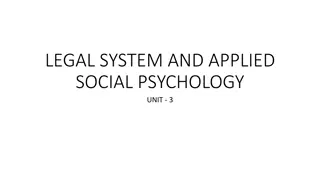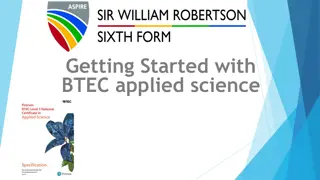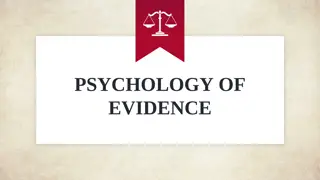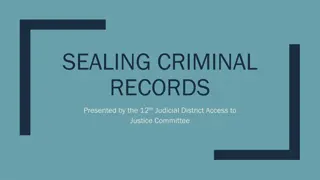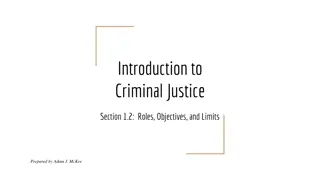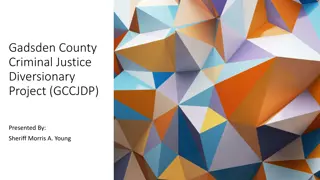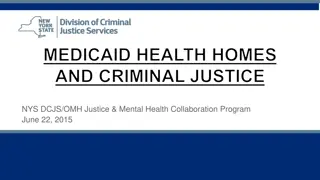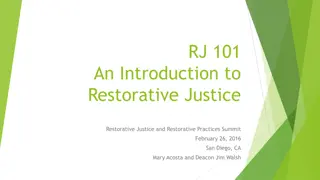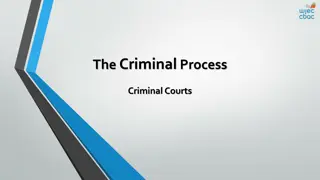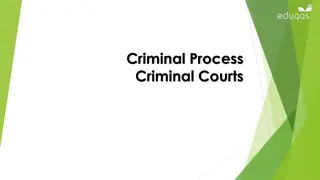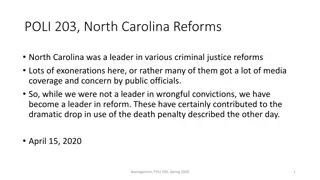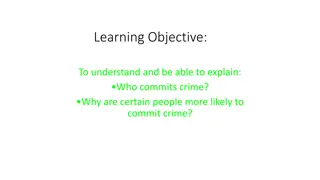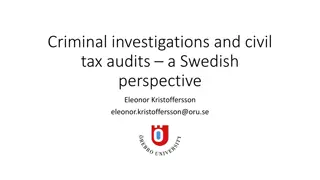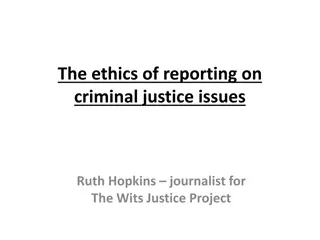Associate of Applied Science in Criminal Justice Learning Outcomes Report
This report outlines the learning objectives for students completing the Associate of Applied Science degree in Criminal Justice, covering various competencies and skills in the field. It also discusses how Bloom's Revised Taxonomy is incorporated into the learning outcomes. Additionally, the report mentions the accreditation status of the program by the Academy of Criminal Justice Sciences Executive Board.
Download Presentation

Please find below an Image/Link to download the presentation.
The content on the website is provided AS IS for your information and personal use only. It may not be sold, licensed, or shared on other websites without obtaining consent from the author. Download presentation by click this link. If you encounter any issues during the download, it is possible that the publisher has removed the file from their server.
E N D
Presentation Transcript
The Department of Criminal Justice and Sociology School of Liberal Arts Associate of Applied Science in Criminal Justice CIP Code: Program Code: 430107 550 Program Quality Improvement Report 2010-2011 Fall 2010 1
Program Learning Objectives The student upon completing the Associate of Applied Science degree in Criminal Justice should be able to: 1. Demonstrate competency in the field of Criminal Justice in general; recognize and identify history, development, functions, and procedures of the three major components of the Criminal Justice System. Demonstrate competency in the area of law; identifying the various types and functions. Demonstrate competency in the area of policing in America; recognize and identify history, development, functions, and procedures. Demonstrate competency in the area of corrections in America; recognize and identify history, development, functions, and procedures. Demonstrate competency in the area of the American court system; recognize and identify history, development, functions, and procedures of the various types and levels. Demonstrate competency in the area of criminological theory; recognize and identify the history, development, functions, and procedures. Demonstrate competency in writing effectively; following directions, the use of proper grammar, spelling, and citation. Demonstrate computer literacy. 2. 3. 4. 5. 6. 7. 8. Program Quality Improvement Report 2010-2011 Fall 2010 2
Program Learning Objectives and Bloom s Revised Taxonomy Revised Bloom's Taxonomy Program Quality Improvement Report 2007-2008 Fall 2008 3
How all of the Associate of Applied Science in Criminal Justice Learning Outcomes Incorporate Bloom s Revised Taxonomy Students are expected to remember (Level 1) a wide range of criminal justice concepts, including history, development, functions, foundational assumptions, and central ideas (Learning Outcomes 1-8). Students are also expected to understand, apply, and analyze (Levels 2-4) theories of criminal behavior in their proper contexts (Learning Outcome 6-8). Students are also expected to understand, apply, and analyze (Levels 2-4) the philosophy and various types of law with regard to the police, court, and corrections, (Learning Outcome 2-8). Students are also expected to evaluate (Level 5) the assumptions, central ideas, and dominant criticisms of the Criminal Justice System (Learning Outcomes 1-8). Program Quality Improvement Report 2010-2011 Fall 2010 4
Accrediting Agency The following programs have been certified by the Academy of Criminal Justice Sciences Executive Board. The length of ACJS certification for each program is ten (10) years from the date of Board approval. The Associate of Applied Science Degree in Criminal Justice uses ACJS certification guidelines when reviewing program objectives and curriculum. The Associate of Applied Science Degree is not accredited by an outside organization/agency. It is the intent of the Criminal Justice and Sociology Department to seek certification in the future for the Associate of Applied Science Degree. Name of Certified Degree Program Institution Date Approved Certification Bachelor of Science - Criminal Justice Fayetteville State University March 10, 2009 Bachelor of Science - Criminal Justice University of Baltimore March 10, 2009 Bachelor of Science - Criminal Justice Penn State Harrisburg March 10, 2009 Master of Science - Criminal Justice Washburn University September 7, 2007 Master of Science - Criminal Justice University of Baltimore March 10, 2009 Master of Arts - Criminal Justice Radford University March 10, 2009 Master of Science - Criminal Justice Radford University March 10, 2009 Program Quality Improvement Report 2010-2011 Fall 2010 5
Alignment of Learning Outcomes A. Learning Outcomes and the Cameron University Mission Statement B. Learning Outcomes and the School of Liberal Arts Mission Statement C. Learning Outcomes and the Department Mission Statement D. Learning Outcomes and the Cameron University Strategic Plan 2013 Program Quality Improvement Report 2010-2011 Fall 2010 6
Learning Outcomes and the Cameron University Mission Statement Cameron University provides: a diverse and dynamic student body access to quality educational opportunities; fosters a student-centered academic environment that combines innovative classroom teaching with experiential learning; prepares students for professional success, responsible citizenship, life-long learning, and meaningful contributions to a rapidly changing world; and is a driving force in the cultural life and economic development of the region. Program Quality Improvement Report 2010-2011 Fall 2010 7
The Associates of Applied Science degree in Criminal Justice, in the spirit of the Universitys Mission Statement, serves a diverse and dynamic student population. The program provides its student population with quality educational opportunities, student centered academics, innovative classroom teaching, and professional success through its: curriculum, diverse, qualified faculty that provide an array of differing teaching techniques and styles, access to high quality textbooks and resource materials, access to the latest hardware and software, access to top peer reviewed and professional journals, guest lectures, field trips, student organizations, honor societies, opportunities to participate in various community service projects, opportunities to participate in state, regional, and national professional organizations, and; student collaboration with faculty members research agendas. Program Quality Improvement Report 2010-2011 Fall 2010 8
Learning Outcomes and the School of Liberal Arts Mission Statement The mission of the School of Liberal Arts is to offer quality associate and baccalaureate programs in the fine arts, humanities, and social sciences. The School also plays an important role in general education. In our programs and course offerings, the School of Liberal Arts fosters a student-centered academic environment, in keeping with the mission of the University, and is dedicated to guiding students to the highest possible standard of achievement. The School of Liberal Arts also actively seeks to make the University a driving force in the cultural life and economic development of the region by encouraging faculty scholarship, developing partnerships with the community, and producing concerts, recitals, theatre productions, art exhibitions, lectures, symposia, workshops, camps, and public forums which enrich the intellectual and cultural lives of all of our constituents. Program Quality Improvement Report 2010-2011 Fall 2010 9
Alignment of Criminal Justice Program Objectives with the School of Liberal Arts Mission Statement The Criminal Justice program concurs with the mission statement of the School of Liberal Arts as follows: It offers a quality Associate of Applied Science degree It provides a student-centered academic environment It is dedicated to guiding students through advisement to attain the highest standard of achievement. It enriches the intellectual and cultural lives of students through department students social events. Program Quality Improvement Report 2010-2011 Fall 2010 10
Learning Outcomes and the Department Mission Statement The Department of Criminal Justice and Sociology at Cameron University offers programs leading to a Bachelor of Science degree with a major in Criminal Justice, a Bachelor of Science degree with a major in Sociology, and an Associate Degree in Applied Science in Criminal Justice. Our academic programs empower students to explore their interests, express their ideas, and experience the pride of uncovering new knowledge. The Criminal Justice programs allow students to learn about the etiology of crime and societal reaction to the causes of crime. The role of law enforcement agencies, courts, correctional agencies, and private agencies that assist in the prevention and control of crime and delinquency are within the purview of the Criminal Justice programs. The Sociology degree provides critical knowledge to students on social institutions, social change, and consequences of human behavior. Students learn to apply research skills and theoretical knowledge to the challenging issues of our times. Graduates of our programs find employment with criminal justice agencies, social services, government agencies, teaching, or proceed to graduate school. Program Quality Improvement Report 2010-2011 Fall 2010 11
Alignment of Criminal Justice Program Objectives with the Department of Criminal Justice and Sociology Mission Statement The Criminal Justice program supports the mission statement of the Department of Criminal Justice as follows: Students will demonstrate competence and understanding of etiology of crime and societal reactions to the causes of crime. Students will demonstrate competence in the broader field of the Criminal Justice System such as law enforcement, courts, and corrections. Students will demonstrate competence in the area of theories of crime. Program Quality Improvement Report 2010-2011 Fall 2010 12
Learning Outcomes and the Cameron University Strategic Plan 2013 Plan 2013 Becoming the University of Choice by providing students a top quality education. Offering the College Experience of Choice by fostering a traditional collegiate atmosphere. Being the Location of Choice for community and regional events. Being the Partner of Choice by expanding existing and developing new community and area partnerships that will contribute to the growth and prosperity of Southwest Oklahoma. 1. 2. 3. 4. Program Quality Improvement Report 2010-2011 Fall 2010 13
The University of Choice The Associates of Applied Science degree in Criminal Justice meets the first goal of the Plan 2013 by: Providing the highest quality in instruction; Offering diverse concentrations; law enforcement and corrections; Assuring efficient, effective course delivery in multiple formats; on ground, ITV, and online; Providing opportunities for students and faculty to demonstrate their scholarship in regional and national forums; Regional Research Day, Oklahoma Criminal Justice Association, Southwestern Criminal Justice Association, and Academy of Criminal Justice Sciences; Attracting, developing, and retaining diverse, high quality faculty and staff, and; Increasing the communication with and accountability to external constituencies by expanding the use of academic program Advisory Committees. Program Quality Improvement Report 2010-2011 Fall 2010 14
The College Experience of Choice The Associates of Applied Science degree in Criminal Justice meets the second goal of the Plan 2013 by: Implementing centralized academic advisement for lower division students, Strengthening the sense of community among students, faculty, staff, and alumni through departmental socials and student organizations; Alpha Phi Sigma and Criminal Justice Student Association, Promoting an active campus life by focusing on athletics, cultural events, student, programs, and organizations, Co-sponsoring events with student development to promote and advocate an active campus life. Program Quality Improvement Report 2010-2011 Fall 2010 15
The Location of Choice The Associates of Applied Science degree in Criminal Justice meets the third goal of the Plan 2013 by: Utilizing and marketing campus facilities to promote Cameron University at the Location of Choice for regional and statewide events and conferences; Oklahoma Criminal Justice Association (2007), and S.T.O.P. Violence Against Indian Women Conference at Redlands (2008), and; Faculty s continued promotion of and support for on-campus recycling. Program Quality Improvement Report 2010-2011 Fall 2010 16
The Partner of Choice The Associates of Applied Science degree in Criminal Justice meets the fourth goal of the Plan 2013 by: Strengthening partnership with Fort Sill to provide educational and social opportunities for soldiers and their dependents; multiple courses offered on base annually, Increasing Cameron University Alumni Association membership through honor society and student organization, Developing partnerships with area businesses and industries including encouraging use of conferencing facilities; Lawton Police Department, Comanche County Sheriff s Department, Comanche Nation, Army Community Service, Central Mall Security, Comanche County Hospital, S.T.O.P. Violence Against Indian Women, TSA, and Emergency Management. Program Quality Improvement Report 2010-2011 Fall 2010 17
Measures of Learning and Service Outcomes 1. Direct measures of student learning or service outcomes. 2. Indirect measures of student learning or service outcomes. 3. Strategies or methodologies that address shortfalls in student learning or services. Program Quality Improvement Report 2010-2011 Fall 2010 18
Direct Measures of Student Learning or Service Outcomes Components of The Educational Testing Service MFT in Criminal Justice are used for Learning Outcomes 1-6. Students are expected to score at or above the national average on the relevant parts of the MFT in Criminal Justice for these Learning Outcomes to be met. 1. Student will demonstrate competency in the field of Criminal Justice in general. We use the MFT Total Score to measure learning outcome . Students will demonstrate competency in the area of law. We use the MFT sub-score Section One: Law to measure learning outcome. Students will demonstrate competency in the area of policing in America. We use the MFT sub-score Section Two: Law Enforcement to measure learning outcome. Students will demonstrate competency in the area of corrections in America. We use the MFT sub-score Section Three: Corrections to measure learning outcome. Students will demonstrate competency in the area of the American court system. We use the MFT sub-score Section Four: The Court Systems in the United States to measure learning outcome. Students will demonstrate competency in the area of criminological theory. We use the MFT sub-score Section Five: Theories of Criminal Behavior to measure learning outcome. 2. 3. 4. 5. 6. Program Quality Improvement Report 2010-2011 Fall 2010 19
Students paper scores from Criminal Justice Courses are used to assess Learning Outcome 7. Student Averages are expected to be 70% or above for this Learning Outcome to be met. 7. Students will demonstrate competency in writing effectively. We use the scores from papers written in Criminal Justice courses to measure learning outcome; CJ 1033, 2033 and 2023. 8. Students will demonstrate computer literacy. Passing grade in CIS 1013; Introduction to Computer Information Systems to asses learning outcome. Program Quality Improvement Report 2010-2011 Fall 2010 20
Indirect Measures of Student Learning or Service outcomes The Associate of Applied Science Degree incorporates the following indirect measures for assessing student learning outcomes: MFT follow-up surveys; and, student graduation surveys Program Quality Improvement Report 2010-2011 Fall 2010 21
Strategies or Methodologies that address shortfalls in Student Learning or Services The Criminal Justice Faculty use the following strategies/methodologies in address shortfalls in current and future student learning: Early Alert System (Banner) to alert students about poor grades Criminal Justice Advisory Committee Program Quality Improvement Report 2010-2011 Fall 2010 22
Report on Actions from the Three Previously Chosen Priority Outcomes The three outcomes listed below were selected in the 2009 PQIR assessment. 2009 PO#1 Discuss the historical development of the criminal justice system in the United States. 2009 PO #2 Discuss the history, development, philosophy, practice, and functions in one of the two specializations; law enforcement and/or corrections. 2009 PO #3 Communicate effectively in writing; following directions, the use of proper grammar, spelling, and citations. Each outcome will be discussed in the next several slides, including any historical trends and actions taken to resolve outcome shortfalls. Program Quality Improvement Report 2010-2011 Fall 2010 23
Report on Previous (2009) Priority Outcomes 2009 PO#1 Discuss the historical development of the criminal justice system in the United States. Multi-year data between Fall 2007 and Spring 2009 indicate scores were above the national average until Spring 2009. Specific actions taken to address this outcome: TheCriminal Justice faculty have re-conceptualized the program objectives. The Criminal Justice faculty continuously evaluate the adequacy of course materials and seek to improve the curriculum in order to address MFT assessment areas. The Criminal Justice and Sociology department has successfully hired two additional terminally degreed faculty to reduce the heavy reliance on adjunct faculty as well as teach additional proposed course offerings. Semester/Year National Institutional Mean Scores (N=102) 151 150 150 150 Cameron University Mean Score % of schools at or below CU s Mean Score 40% 30% 45% 25% Fall 2007 Spring 2008 Fall 2008 Spring 2009 153 152 152 147 Program Quality Improvement Report 2010-2011 Fall 2010 24
Report on Previous (2009) Priority Outcomes 2009 PO #2 Discuss the history, development, philosophy, practice, and functions in one of the two specializations; law enforcement and/or corrections. Multi-year data between Fall 2007 and Spring 2009 indicate a yo-yo affect in the MFT sub-scores Law Enforcement and Corrections in relation to the national average. Specific actions taken to address this outcome: TheCriminal Justice faculty have re-conceptualized the program objectives. The Criminal Justice faculty continuously evaluate the adequacy of course materials and seek to improve the curriculum in order to address MFT assessment areas. The Criminal Justice and Sociology department has successfully hired two additional terminally degreed faculty to reduce the heavy reliance on adjunct faculty as well as teach additional proposed course offerings. Indicator Number Term Indicator Title National Institutional Mean (N=95) Cameron Institutional Mean 3 Law Enforcement Fall 2007 51.7 57 Spring 2007 51.7 48 Fall 2008 51.7 52 Spring 2008 51.3 51 Fall 2009 51.2 46 Spring 2009 51.2 50 Program Quality Improvement Report 2010-2011 Fall 2010 25
Indicator Number Term Indicator Name National Institutional Mean (N=95) Cameron Institutional Mean 4 Corrections Fall 2006 48.8 50 Spring 2007 48.8 42 Fall 2007 48.8 51 Spring 2008 48.9 47 Fall 2008 48.7 43 Spring 2009 48.7 45 Program Quality Improvement Report 2010-2011 Fall 2010 26
Report on Previous (2009) Priority Outcomes 2009 PO #3 Communicate effectively in writing; following directions, the use of proper grammar, spelling, and citations. Multi-year data between Spring 2008 and Summer 2009 indicate that, when staff was sufficient, students learning objective was met. Specific actions taken to address this outcome: TheCriminal Justice faculty have re-conceptualized the program objectives. The Criminal Justice and Sociology department has successfully hired two additional terminally degreed faculty to reduce the heavy reliance on adjunct faculty as well as teach additional proposed course offerings; CJ 1033,2033, and 2023. Course Number Term (N) Percentage CJ 2023 Spring 08 33 29 87% CJ 2023 Summer 08 8 7 90% CJ 2023 Fall 08 N/A CJ 2023 Spring 09 N/A CJ 2023 Summer 09 N/A Program Quality Improvement Report 2010-2011 Fall 2010 27
Priority Learning or Service Outcomes (2010) 1. Student will demonstrate competency in the field of Criminal Justice in general; recognize and identify history, development, functions, and procedures of the three major components of the Criminal Justice System. Students will demonstrate competency in the area of law; identifying the various types and functions. Students will demonstrate competency in the area of policing in America; recognize and identify history, development, functions, and procedures. Students will demonstrate competency in the area of corrections in America; recognize and identify history, development, functions, and procedures. Students will demonstrate competency in the area of the American court system; recognize and identify history, development, functions, and procedures of the various types and levels. Students will demonstrate competency in the area of criminological theory; recognize and identify the history, development, functions, and procedures. Students will demonstrate competency in writing effectively; following directions, the use of proper grammar, spelling, and citation. Students will demonstrate computer literacy. 2. 3. 4. 5. 6. 7. 8. Program Quality Improvement Report 2010-2011 Fall 2010 28
Student-Learning or Service Outcome and Measurements (2010 Program Outcome # 1) MEASUREMENTS OF STUDENT LEARNING OR SERVICE OUTCOME CURRICULUM AREA OR TARGET AUDIENCE Methods used to determine validity of measurement instruments Methods used to determine reliability of measurements PROGRAM OUTCOME Schedule for measurement Measurements Student will demonstrate competency in the field of Criminal Justice in general; recognize and identify history, development, functions, and procedures of the three major components of the Criminal Justice System. All Criminal Justice Courses. We use the MFT Total Score (direct measure) to measure learning outcome . The Major Field Test (MFT) was initiated in 2007. The educational Testing Service constructs the MFT with an emphasis on validity and reliability. A full description of their test development process can be obtained from visiting their website: http://www.ets.org. The Major Field Test (MFT) was initiated in 2007. The educational Testing Service constructs the MFT with an emphasis on validity and reliability. A full description of their test development process can be obtained from visiting their website: http://www.ets.org. Fall/Spring Semesters. Program Quality Improvement Report 2010-2011 29
Display of Assessment Data (2010 Program Outcome # 1) The total population size for the fall (n=9) and spring (n=48) MFT is 57. The mean score is 151 with a standard deviation of 12. The total population includes both two-year (AAS) and four-year (BS) student scores. The Criminal Justice faculty have no way of separating out the MFT scores for the two year (AAS) from the four-year (BS ) students scores. The Criminal Justice faculty have made requests in the past for comparative MFT data on peer institutions, but have never received such data. Program Quality Improvement Report 2010-2011 Fall 2010 30
Display of Assessment Data (2010 Program Outcome # 1) Semester/Year National Institutional Mean Scores (N=117) 151 Cameron University Mean Score % of schools at or below CU s Mean Score 40% Fall 2007 153 Spring 2008 150 152 30% Fall 2008 150 152 45% Spring 2009 150 147 25% Fall 2009 150 148 25% Spring 2010 150 152 45% Program Quality Improvement Report 2010-2011 Fall 2010 31
Action Plan (2010 Program Outcome # 1) 1. The Criminal Justice faculty will develop, test, and implement an in house assessment for the Associate of Applied Science in Criminal Justice. The Criminal Justice faculty will continue to re-conceptualize the program objectives to be used from the department mission statement all the way through to course syllabus outcomes. The Criminal Justice faculty/curriculum committee will review and revise current curriculum as well as prerequisites. The Criminal Justice faculty will complete work and set up basic forensic lab. The Criminal Justice faculty will continue to strengthen advisement portion of the department to meet student s advisement needs. The Criminal Justice faculty will continue to strengthen various delivery methods to meet the needs of non-traditional students. The Criminal Justice faculty will continue to utilize various assignments and teaching strategies recommended in previous PQIR reports. 2. 3. 4. 5. 6. 7. Program Quality Improvement Report 2010-2011 Fall 2010 32
Student-Learning or Service Outcome and Measurements (2010 Program Outcome # 2) MEASUREMENTS OF STUDENT LEARNING OR SERVICE OUTCOME Methods used to determine validity of measurement instruments Schedule for measurem ents CURRICULUM AREA OR TARGET AUDIENCE Methods used to determine reliability of measurements PROGRAM OUTCOME Measurements Students will demonstrate competency in the area of policing in America; recognize and identify history, development, functions, and procedures. CJ 1013, 1023, 1033, 1113, and 2033. We use the MFT sub-score Section Two: Law Enforcement (direct measurement) to measure learning outcome. The Major Field Test (MFT) was initiated in 2007. The educational Testing Service constructs the MFT with an emphasis on validity and reliability. A full description of their test development process can be obtained from visiting their website: http://www.ets.org. The Major Field Test (MFT) was initiated in 2007. The educational Testing Service constructs the MFT with an emphasis on validity and reliability. A full description of their test development process can be obtained from visiting their website: http://www.ets.org. Fall/ Spring Semesters. LE 2003, 2013, 2043, 2053, and 2063. Program Quality Improvement Report 2010-2011
Analysis of Assessment Data (2010 Program Outcome # 2) Indicator Number Term Indicator Title National Institutional Mean (N=117) Cameron Institutional Mean Law Enforcement Fall 2007 51.7 57 Spring 2007 51.7 48 Fall 2008 51.7 52 Spring 2008 51.3 51 Fall 2009 51.2 46 Spring 2009 51.2 50 Fall 2009 51.0 50 Spring 2010 51.0 50 The total population size for the fall (n=9) and spring (n=48) MFT is 57. The mean score of the Law Enforcement sub- section of the MFT is 50 with a standard deviation of 0. The total population includes both two-year (AAS) and four-year (BS) student scores. The Criminal Justice faculty have no way of separating out any of the sub-scores of the MFT for the two year (AAS) from the four-year (BS ) students scores. The Law Enforcement sub-scores for the fall (n=9) and spring (n=48) MFT are below the national institutional mean. However, there was an increase in scores in the spring 2009 from the fall 2009 and they have been holding steady even since. Program Quality Improvement Report 2010-2011 Fall 2010 34
Action Plan (2010 Program Outcome # 2) 1. The Criminal Justice faculty will develop, test, and implement an in house assessment for the Associate of Applied Science in Criminal Justice. The Criminal Justice faculty will continue to re-conceptualize the program objectives to be used from the department mission statement all the way through to course syllabus outcomes. The Criminal Justice faculty/curriculum committee will review and revise the Law Enforcement concentration curriculum as well as prerequisites. The Criminal Justice faculty will complete work and set up basic forensic lab. The Criminal Justice faculty will continue to strengthen advisement portion of the department to meet student s advisement needs. The Criminal Justice faculty will continue to strengthen various delivery methods to meet the needs of non-traditional students. The Criminal Justice faculty will continue to utilize various assignments and teaching strategies recommended in previous PQIR reports. 2. 3. 4. 5. 6. 7. Program Quality Improvement Report 2010-2011 Fall 2010 35
Student-learning or service outcome and measurements (2010 Program Outcome # 3) MEASUREMENTS OF STUDENT LEARNING OR SERVICE OUTCOME Methods used to determine validity of measurement instruments Schedule for measurem ents CURRICULUM AREA OR TARGET AUDIENCE Methods used to determine reliability of measurements PROGRAM OUTCOME Measurements Students will demonstrate competency in the area of corrections in America; recognize and identify history, development, functions, and procedures. CJ 1013, 1023, 1033, 1113, and 2033. We use the MFT sub-score Section Three: Corrections (direct measurement) to measure learning outcome. The Major Field Test (MFT) was initiated in 2007. The educational Testing Service constructs the MFT with an emphasis on validity and reliability. A full description of their test development process can be obtained from visiting their website: http://www.ets.org. The Major Field Test (MFT) was initiated in 2007. The educational Testing Service constructs the MFT with an emphasis on validity and reliability. A full description of their test development process can be obtained from visiting their website: http://www.ets.org. Fall/ Spring Semesters. CORR 2003, 2013, 2023, 2043, and 2053. Program Quality Improvement Report 2010-2011
Display of Assessment Data (2010 Program Outcome # 3) Indicator Number Term Indicator Name National Institutional Mean (N=117) Cameron Institutional Mean Corrections Fall 2006 48.8 50 Spring 2007 48.8 42 Fall 2007 48.8 51 Spring 2008 48.9 47 Fall 2008 48.7 43 Spring 2009 48.7 45 Fall 2009 48.8 43 Spring 2010 48.8 47 The total population size for the fall (n=9) and spring (n=48) MFT is 57. The mean score of the Correction sub-section of the MFT is 45 with a standard deviation of 2.828. The total population includes both two-year (AAS) and four-year (BS) student scores. The Criminal Justice faculty have no way of separating out any of the sub-scores of the MFT for the two year (AAS) from the four-year (BS ) students scores. The Corrections sub-scores for the fall (n=9) and spring (n=48) MFT are below the national institutional mean. However, there was an increase in the sub-scores in the spring 2009. Program Quality Improvement Report 2010-2011 Fall 2010 37
Action Plan (2010 Program Outcome # 3) 1. The Criminal Justice faculty will develop, test, and implement an in house assessment for the Associate of Applied Science in Criminal Justice. The Criminal Justice faculty will continue to re-conceptualize the program objectives to be used from the department mission statement all the way through to course syllabus outcomes. The Criminal Justice faculty/curriculum committee will review and revise the Corrections concentration curriculum as well as prerequisites. The Criminal Justice faculty will continue to strengthen advisement portion of the department to meet student s advisement needs. The Criminal Justice faculty will continue to strengthen various delivery methods to meet the needs of non-traditional students. The Criminal Justice faculty will continue to utilize various assignments and teaching strategies recommended in previous PQIR reports. 2. 3. 4. 5. 6. Program Quality Improvement Report 2010-2011 Fall 2010 38
Graduations for the last Five Years Academic Year Summer Fall Spring Academic Year Total 45 2005 7 12 26 29 2006 0 13 16 37 2007 1 13 23 27 2008 2 10 15 32 2009 0 5 27 Program Quality Improvement Report 2010-2011 Fall 2010 39





